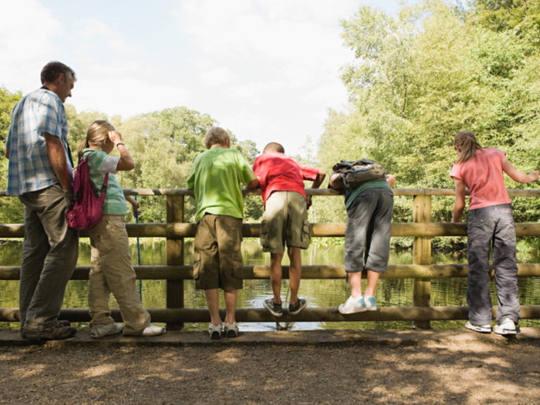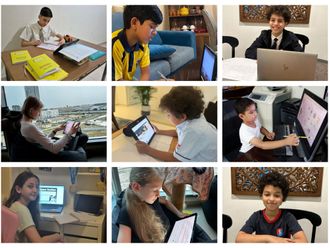
UK: The school run resembles the exodus from a festival. There are vans with hippyish bumper stickers. ‘Homeopathy Heals’ said one, bouncing down a track to the sprawling car park, where women in ponchos hug their babies and chat.
Inside the Steiner Academy Hereford, which occupies a renovated Victorian school and converted farm buildings in the village of Much Dewchurch, it is a picture of pastoral charm.
There is a babbling water feature in a courtyard lined with potted shrubs and a pleasingly old-fashioned wooden staircase leading up to classrooms.
The kindergarten is just that, a triangular garden fringed with pine, apple and cherry trees laden with blossom where children in woolly hats sit on the ground making mud pies.
To the casual observer, the message could not be clearer: this is a school where an appreciation of nature is deeply embedded in children’s lives.
In class, there is an emphasis on teaching through music and physical expression. In one lesson for six-year-olds, the children recite times tables while touching parts of their body, or stepping back and forth over a skipping rope laid flat on the floor. There is a strong sense of the practical side of education.
The Steiner education movement, named after its Austrian founder Rudolf Steiner, describes itself as providing an “unhurried and creative” environment for learning. “It’s about keeping that vitality and that freshness and that twinkling eye,” said Trevor Mepham, principal of the Hereford school. “I think that’s common sense, though. It’s just that we arguably try to do that as a matter of course.”
Free School
In England, Steiner education is on the brink of a significant expansion. at present, the academy in Herefordshire is the only one to receive state funding out of 34 Steiner schools in the UK.
In September, it will be joined by a state-funded “free school” in Frome, Somerset. Two more Steiner schools in Leeds and Exeter are applying for state funding under the free schools programme.
There is something undeniably wholesome about the Steiner approach. In an age when toddlers are adept at using iPhones, the idea of children building shelters in the woods is profoundly attractive to parents.
Access to television is restricted under the home-school agreement with parents, children are not meant to watch TV before the age of eight.
There is no uniform; the children wear hoodies, sturdy trousers and plimsolls and the canteen serves mainly vegetarian food. A homely vegetable curry spiced with mustard seeds is dish of the day when I visit.
As in Scandinavia, children start their formal education later. The first year group in the Herefordshire School is a class of children who have their seventh birthdays this year.
“As human beings we have a close and important relationship with the natural world. To pretend that we just need gadgetry and technology, misses out a very vital part of the piece,” Mepham said. “Especially when children are young, we need to try to foster in them an interest and sense of inquiry and hopefulness about the natural world.”
The Herefordshire School offers just five GCSEs: English, English literature, maths, Spanish and art. No physics, chemistry, biology, geography or history. It is quite common for pupils to take just the English and maths GCSEs, and a BTEC in Countryside and Environment.
Not for Everyone
Mark Hayes, director of Cambridge University’s eScience group, which specialises in the application of computer science, has explored the Steiner approach to science and is disquieted by what he found.
When Hayes contacted the academy to discuss their science teaching, he was referred to a book on the Steiner curriculum that the school uses as a guide.
Darwinism, the book notes, is “rooted in reductionist thinking and Victorian ethics”, while homeopathy is given as an example of “an effect that cannot be explained”.
A typical passage on biology reads: “A reductionist biology which states or implies that the human body is a machine is not one which nourishes the adolescent’s deepest concerns. The current theories are just that - theories. They have not been in existence long and though presented as ‘truth’ they will inevitably change.”
Hayes became interested in Steiner when he was looking at private education for his son. “One of the things that attracted us to it was the fees, which are considerably lower than other private schools,” he said.
“The schools market themselves as being based around the arts, children spend a lot of time outdoors and there are gardening lessons. They go off into the woods once a week.”
The family joined a Steiner parent-and-child group in Cambridge, but Hayes quickly felt like an outsider.
“I can remember feeling slightly patronised, as probably the only person around the table that did not see alternative medicine as a great thing.”
Behind the Steiner movement is the philosophy its founder devised, known as anthroposophy. “What’s unique about the Steiner schools is anthroposophy as a basis to education. The way they stick very rigidly to the Steiner philosophy,” said Hayes. “There is an emphasis on reverence for nature.”
Science vs Art
When asked what she likes about the school, Gabrielle Johnson, 15, said: “It’s the subjects we study and the way we study them. It’s not all about getting a good mark – it’s about getting the information in between.”
When I visit, Johnson and her classmates are engaged in a debate on the ethics of zoo keeping. It is part of a day spent exploring how to make an argument, which began with pupils singing protest songs, and watching the Monty Python “argument” sketch.
The philosophy class is not part of the national curriculum, but the Steiner curriculum, which the school is allowed to offer because it is an academy.
Johnson loves drama and likes the idea of going into acting. Her classmate, Conor Clarke McGrath, 15, has similar ambitions. He is doing just three GCSEs — English language, literature and maths, as well as the environmental BTEC. When I say this is not a lot, he replies: “I’m grateful for that.”
When asked what he plans to do, he said: “I’d like to act, so theatre studies at the sixth form (final year) I think, and a few others such as English and history.”
If acting doesn’t work out? “I’d be a struggling author.”
There are some successful performers among Steiner alumni, such as Jennifer Aniston and Annie Lennox - who named the Eurythmics after eurhythmy, a Steiner exercise involving stretching and hopping to music.
However, if these children can not make a living as actors or writers, what might they do? The Steiner movement insists there are distinguished scientists among its ex-pupils such as the US physicist John Fitzallen Moore — but it is much harder to make up lost ground in physics or maths than it is in the humanities.
“There are different ways of approaching science, aren’t there? We would argue that we do lots of science, and we do it in a scientific way,” said Mepham.
Mixed Feelings
Jonathan Godfrey, principal of Hereford sixth form college, confirms that the small number of GCSEs Steiner pupils take has “never been an issue” when it comes to doing A-levels. There may be some gaps in their knowledge, but Godfrey said this applies equally to children who have done the “double science” GCSE at other schools, rather than taking individual sciences.
Godfrey admitted, however, that most Steiner pupils go on to choose the humanities over science. However, he is enthusiastic about their ability to learn. “What you do find is they are articulate and motivated and mature in many respects,” he said. “They are more willing to take responsibility for their own learning than traditional students.”
-Guardian News and Media 2012












